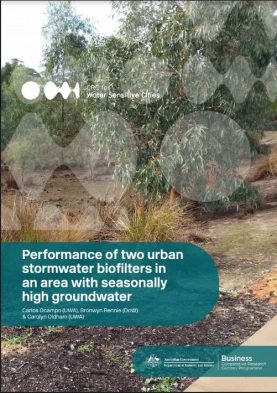Performance of two urban stormwater biofilters in an area with seasonally high groundwater
Abstract
Biofilters are used in urban areas throughout the world to attenuate storm flows and stormwater nutrient loads. Many urban developments on the Swan Coastal Plain in Western Australia experience a seasonally high water table; when the water table intercepts the biofilters it is more challenging to determine the consequences for biofilter performance. This report sets out methods for assessing performance of two biofilters (a raingarden and a bioretention basin) over a year that included the high water table conditions, quantifies both the hydrological and nutrient removal performance of the two systems, and makes recommendations for improved performance. Specifically, we aimed to:
- quantify the effectiveness of each type of biofilter in reducing runoff volumes and peaks,
- quantify the nutrient removal performance of each of the biofilters,
- quantify the effect high groundwater has on each of the biofilter’s hydrological functioning and nutrient removal performance, and
- quantify any changes in nutrient concentrations and speciation from the inflows to the outflows.
The study site was within The Glades development, a residential area located at the base of the Darling Scarp, approximately 2 km south west of the Byford town centre, Perth, Western Australia. The median strip raingarden and the bioretention basin were part of a series of structural controls to treat stormwater before discharging into Cardup Brook Tributary 6, which is a surface water tributary of the Peel-Harvey estuary. The shallow soil consists of sands overlying hardpan layers (locally known as duplex soils) that can create seasonally perched shallow water tables. The regional water table typically rises over winter to incorporate the perched layers into a continuous saturated soil profile. In below-average rainfall years the lower recharge may maintain the regional water table below the perched shallow water table.
